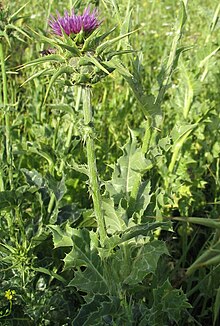
Back سلبين Arabic سلبين ARZ Alaqanqal Azerbaijani Дөйә үләне Bashkir Растаропша Byelorussian Silybum Catalan Silybum CEB Mariendisteln German Silybum Spanish Maarjaohakas (perekond) Estonian
| Milk thistle | |
|---|---|

| |
| Silybum marianum | |
| Scientific classification | |
| Kingdom: | Plantae |
| Clade: | Tracheophytes |
| Clade: | Angiosperms |
| Clade: | Eudicots |
| Clade: | Asterids |
| Order: | Asterales |
| Family: | Asteraceae |
| Subfamily: | Carduoideae |
| Tribe: | Cardueae |
| Subtribe: | Carduinae |
| Genus: | Silybum Adans. |
| Type species | |
| Carduus marianus[1] | |
| Species | |
| Synonyms[2] | |
| |
Silybum (milk thistle) is a genus of two species of thistles in the family Asteraceae.[1][3] The plants are native to the Mediterranean regions of Europe,[4] North Africa, and the Middle East. One species has been introduced elsewhere, including in North America.[5] The name "milk thistle" derives from a feature of the leaves, which are prominently banded with splashes of white. Historically, these milky bands were said to be Mother Mary's milk, and this is the origin of another common name, St. Mary's thistle. The most widespread species is Silybum marianum.[6]
Claims have been made since ancient times[when?][where?] that the active flavanoid-lignan (flavanolignan) group of constituents, called silymarin, contained only in the seed shell has liver-protective and regenerative properties, as well as antioxidant effects. Chemical, pharmacological, and safety research started in Germany in the 1950s[citation needed].
- ^ a b Tropicos, Silybum Vaill.
- ^ Tropicos search for Silybum
- ^ Vaillant, Sébastien. 1754. Der Konigl. Akademie der Wissenschaften in Paris Physische Abhandlungen 5: 173, 605
- ^ "Herbs At A Glance – Milk Thistle". National Center for Complementary and Integrative Health. Retrieved 2 December 2012.
- ^ "Silybum in Flora of North America @". Efloras.org. Retrieved 2022-05-01.
- ^ Altervista Flora Italiana, Cardo mariano, Blessed Milkthistle, Variegated Thistle, silybe de Marie, Mariendistel, Silybum marianum (L.) Gaertn. includes photos and distribution maps
© MMXXIII Rich X Search. We shall prevail. All rights reserved. Rich X Search